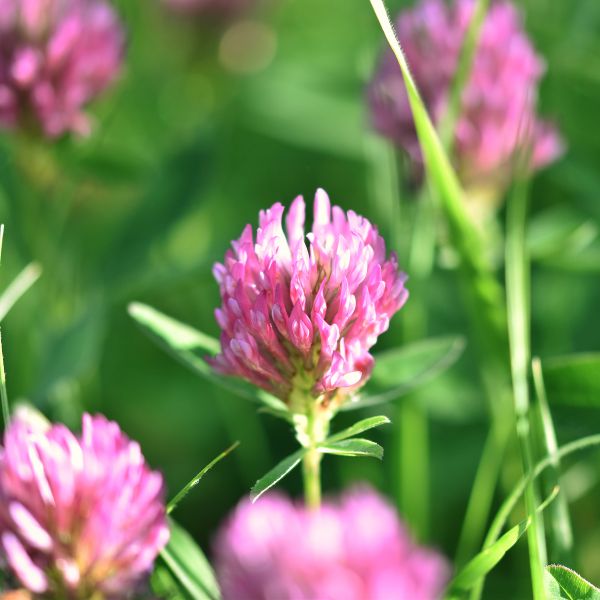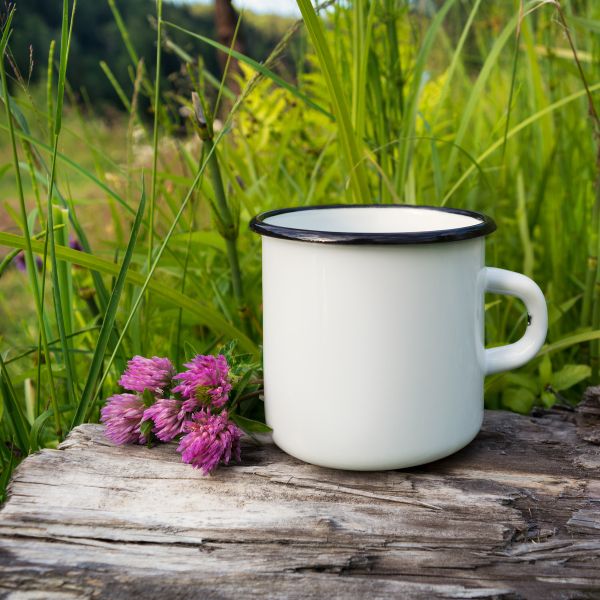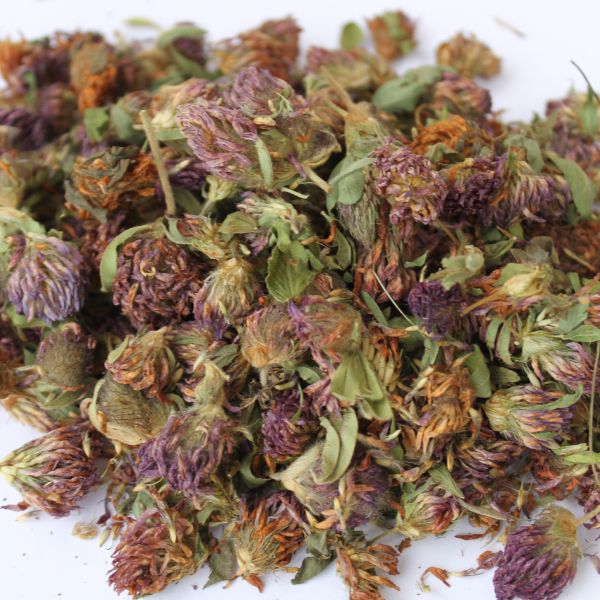Learn the hidden health benefits of clover, Trifolium pratense.
Beneath our feet, often overlooked, the common clover is no ordinary green carpet. As a long-standing symbol of luck and prosperity, its benefits stretch beyond the lore of ancient cultures and into the realm of modern holistic health. Clover, specifically red clover (Trifolium pratense), offers many hidden health benefits that can easily be incorporated into a natural wellness routine.
Botanically, Trifolium pratense is not a weed. Instead, it is a perennial herb, once revered by many.
In fact, red clover has been used for centuries in traditional medicine systems across the globe. Before modern medicine, traditional healers relied on it for ages to help with respiratory issues like asthma, to support the lymphatic system, and to alleviate symptoms of skin conditions like eczema and psoriasis.
Please note: This article is for informational purposes only and does not constitute medical advice. Always consult with your primary care doctor or pharmacist before you start any new diet or supplement regimen.
What Does Red Clover Taste Like?

Many admire the flavor of red clover for its pleasant, sweet, and slightly grassy flavor. The blossoms, which are typically part of the plant consumed, have a mild sweetness with a hint of a vanilla-like taste. When dried, the flavor of the blossoms can be likened to a mild and sweet floral tea. Conversely, the leaves have a more fresh, green, and mildly sweet flavor.
Trifolium pratense flowers make a soothing herbal tea that imparts a light, sweet, and mildly earthy flavor. It’s a taste that you may enjoy both hot and cold, often sweetened with a bit of honey or lemon to enhance its natural flavor profile.
Like many plants, the taste can vary slightly depending on the specific growing conditions and harvest time.
Harvesting and preparing clover for consumption can be a gratifying experience that brings you closer to nature. Here are some steps to help ensure you’re harvesting and preparing clover safely and effectively:
Foraging and Selecting Red Clover:
- Season: Red clover typically blooms between late spring and early fall. Harvesting should be done when the flowers are fully bloomed for maximum benefits.
- Location: Choose a location that’s away from roadsides, heavily trafficked areas, and places that might have been sprayed with pesticides or other harmful chemicals. Ensure the area is clean and healthy.
- Identification: Clover is a small plant with leaves divided into three leaflets, but make sure you’re collecting red clover (Trifolium pratense). Red clover is characterized by its round, pink to purplish flowers.
Harvesting trifolium pratense:
- Use your fingers or a pair of scissors to pluck the blossoms and leaves. Try not to pull out the entire plant; this allows the plant to regrow and continue to benefit the local ecosystem.
Cleaning and preparing red clover:
- Cleaning: Rinse the clover leaves and flowers under cool running water to remove any dirt or small insects that may be present. Gently pat dry using a clean towel.
- Preparing: You may consume red clover flowers raw, added to salads, or cooked as a potherb. After being air-dried, the blossoms can be used to make teas or infusions. To dry the blossoms, lay them out in a single layer in a cool, dark, and dry place for about a week or until they’re dehydrated. Store the dried blossoms in an airtight container for later use.
As with any foraging, always ensure you correctly identify the plant before consumption and never consume wild plants from areas that may contain pollutants or pesticides.
And while clover is generally safe for most people, some individuals may experience allergic reactions. If you’re pregnant, breastfeeding, or have a hormone-sensitive condition, consult your healthcare provider before consuming clover.
Remember, you should forage and incorporate wildflowers into your diet responsibly and sustainably.
Health Benefits of Adding Red Clover to Your Diet
Now that you know how to select and collect red clover, let’s look at the potential healthy reasons why you should:
1 – Red clover is a phytochemical powerhouse:
A study from the National Institutes of Health (NIH) underlines that red clover is a rich source of potent phytochemicals, specifically isoflavones. These plant-based compounds exhibit powerful antioxidant properties that can combat oxidative stress in the body, potentially reducing the risk of various chronic diseases, including heart disease and certain cancers.
2 – Bone health and menopause:
The Mount Sinai Medical Center team points to studies that suggest red clover’s isoflavones can help reduce menopausal symptoms like hot flashes and night sweats. Moreover, in a study published on PubMed.gov, red clover has demonstrated the potential to promote bone density in menopausal women. Thus, it is a natural ally against the onset of osteoporosis.
3 – Cardiovascular wellness:
The American Heart Association highlights the role of a heart-healthy diet in overall well-being. Red clover, in this respect, may provide beneficial effects on cardiovascular health. It contains natural compounds that can improve blood circulation and potentially reduce the risk of atherosclerosis. While more studies are underway, the early signs show great promise.
Medical Precautions When Consuming Trifolium pratense
Despite its many potential benefits, red clover can interact with certain medications and may have side effects. For example, its blood-thinning properties could increase the risk of bleeding, especially in people who take blood thinners or have a bleeding disorder. Also, because of its isoflavones, individuals with hormone-sensitive conditions, such as certain types of cancers, should avoid red clover unless advised by a healthcare provider.
How to Make Red Clover Tea

Ingredients:
- 1-2 tablespoons of dried red clover blossoms
- 1 cup of boiling water
- Honey or lemon to taste (optional)
Instructions:
- Harvest and Dry: If you’re using freshly foraged red clover, ensure you have correctly identified, cleaned, and dried the flowers.
- Prepare the Tea: Place the dried Trifolium pratense blossoms in a tea infuser or directly in a teapot.
- Steep: Pour the boiling water over the red clover blossoms. Cover the teapot to keep the heat in and allow the tea to steep for about 15-20 minutes. This allows the isoflavones and other beneficial compounds to infuse into the water.
- Strain: After steeping, if you’ve put the blossoms directly in the pot, strain the tea into a cup using a fine-mesh strainer.
- Serve: You can enjoy the red clover tea as it is or add honey for a bit of sweetness or a slice of lemon for a touch of acidity.
Enjoy the tea while it’s still warm to experience the full soothing and aromatic qualities of the red clover blossoms. You can have it up to two times daily, depending on your preference and tolerance.
It’s worth repeating this caution:
While red clover is generally safe for most people, it’s always best to consult with a healthcare provider before introducing new herbal remedies into your routine. That’s especially true for pregnant or nursing women or anyone with pre-existing medical conditions.
The Takeaway: Red Clover Has the Potential to Support a Healthy Lifestyle
The humble Trifolium pratense is a testament to nature’s bounty, rich with hidden health benefits. As a source of potent phytochemicals and a potential ally for bone health, menopause, and cardiovascular wellness, it is a compelling example of the power of natural remedies. As we journey towards optimal health, let us celebrate and harness the power of nature, one cloverleaf at a time.


